《大学英语读写》课程教学资源(A)Ⅱ_大学英语读写(A)Ⅱ_Book3.Unit3A.text organization
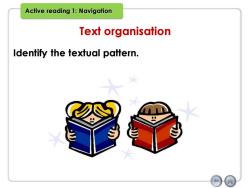
Active reading 1:NavigationTextorganisationIdentify the textual pattern
Text organisation Identify the textual pattern. Active reading 1: Navigation
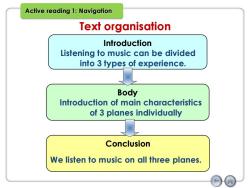
Active reading 1:NavigationTextorganisationIntroductionListening to music can be dividedinto3typesofexperience.BodyIntroduction ofmain characteristicsof 3planesindividuallyConclusionWelistentomusicon all threeplanes
Text organisation Active reading 1: Navigation Body Introduction Conclusion Listening to music can be divided into 3 types of experience. Introduction of main characteristics of 3 planes individually We listen to music on all three planes

糖BodyParas.2~9Paras.2~4The sensuous planeParas.5~7TheexpressiveplaneParas.8~9The musical planeEND
Text Paras. 2~9 Body Paras. 2~4 The sensuous plane Paras. 5~7 The expressive plane Paras. 8~9 The musical plane

Activereading1:NavigationComprehendingthetextRead the passage quickly and choose the bestanswertothe questions
Comprehending the text Read the passage quickly and choose the best answer to the questions. Active reading 1: Navigation
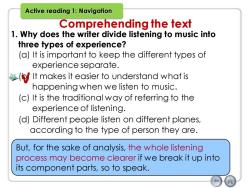
Active reading 1:NavigationComprehendingthe text1. Why does the writer divide listening to music intothree types of experience?(a) It is important to keep the different types ofexperience separate.It makes it easier to understand what isDhappeningwhen we listen to music.(c) It is the traditional way of referring to theexperience of listening.(d) Different people listen on different planesaccording to the type of person they are.But,forthe sake of analysis,the whole listeningprocessmay becomeclearerif webreakitupintoitscomponentparts,sotospeak
Comprehending the text Active reading 1: Navigation 1. Why does the writer divide listening to music into three types of experience? (a) It is important to keep the different types of experience separate. (b) It makes it easier to understand what is happening when we listen to music. (c) It is the traditional way of referring to the experience of listening. (d) Different people listen on different planes, according to the type of person they are. But, for the sake of analysis, the whole listening process may become clearer if we break it up into its component parts, so to speak. √

Active reading 1:NavigationComprehendingthetext2. What is the main characteristic of the sensuous plane?(a) It is the sort of feeling we get when listening tomusic on the radio.(b) It can only be experienced by people who aren'tmusicians.It is a reaction we have whichis generated by thedhakldsound of the music.(d) It does not give us any real sense of pleasure.A kind of brainlessbutattractive stateiof mindisengenderedbythemere sound appeal of themusic
Comprehending the text Active reading 1: Navigation A kind of brainless but attractive state of mind is engendered by the mere sound appeal of the music. 2. What is the main characteristic of the sensuous plane? (a) It is the sort of feeling we get when listening to music on the radio. (b) It can only be experienced by people who aren’t musicians. (c) It is a reaction we have which is generated by the sound of the music. (d) It does not give us any real sense of pleasure
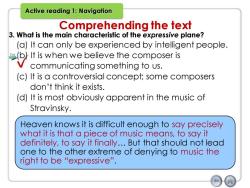
Active reading 1:NavigationComprehendingthetext3. What is the main characteristic of the expressive plane?(a) Itcanonly be experienced by intelligentpeople.(b) It is when webelievethe composeriscommunicating something to us.(c) It is a controversial concept; some composersdon't think it exists.(d) It is most obviously apparent in the music ofStravinsky.Heavenknows itisdifficult enough to say preciselywhat it is that a piece of music means, to say itdefinitely,to say it finally...But that should not leadone to the otherextreme of denyingto music therighttobe"expressive
Comprehending the text Active reading 1: Navigation 3. What is the main characteristic of the expressive plane? (a) It can only be experienced by intelligent people. (b) It is when we believe the composer is communicating something to us. (c) It is a controversial concept; some composers don’t think it exists. (d) It is most obviously apparent in the music of Stravinsky. Heaven knows it is difficult enough to say precisely what it is that a piece of music means, to say it definitely, to say it finally. But that should not lead one to the other extreme of denying to music the right to be “expressive
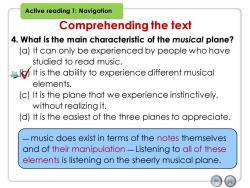
Active reading 1:NavigationComprehendingthetext4. What is the main characteristic of the musical plane?(a)Itcanonlybeexperiencedbypeoplewhohavestudied to read music.It is the ability to experience different musicalek(b)elements.(c) It is the plane that we experience instinctively,without realizing it.(d) It is the easiest of the three planes to appreciate.-musicdoesexistintermsofthenotesthemselvesandof theirmanipulation-Listeningto all oftheseelementsislisteningonthe sheerlymusicalplane
Comprehending the text Active reading 1: Navigation 4. What is the main characteristic of the musical plane? (a) It can only be experienced by people who have studied to read music. (b) It is the ability to experience different musical elements. (c) It is the plane that we experience instinctively, without realizing it. (d) It is the easiest of the three planes to appreciate. — music does exist in terms of the notes themselves and of their manipulation — Listening to all of these elements is listening on the sheerly musical plane
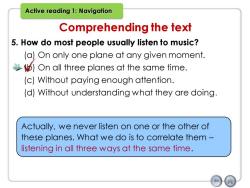
Active reading1:NavigationComprehendingthetext5. How do most people usually listen to music?(a) On only one plane at any given moment.dx- (b) On all three planes at the same time.(c) Without paying enough attention.(d) Without understanding what they are doingActually,wenever listen on one ortheother ofthese planes. What we do is to correlate them:listeninginallthreewaysatthe sametime
Comprehending the text Active reading 1: Navigation Actually, we never listen on one or the other of these planes. What we do is to correlate them – listening in all three ways at the same time. 5. How do most people usually listen to music? (a) On only one plane at any given moment. (b) On all three planes at the same time. (c) Without paying enough attention. (d) Without understanding what they are doing
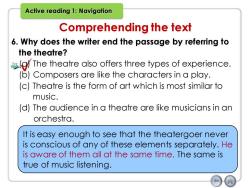
Active reading 1:NavigationComprehendingthetext6.Why does the writer end the passage by referringtothe theatre?loY The theatre also offers three types of experience.(b) Composers are like the characters in a play.(c) Theatre is the form of art which is most similar tomusic.(d) The audience in a theatre are like musicians in anorchestra.It is easy enoughto see that the theatergoer neveris conscious of any of these elements separately.Heis aware of them all at the same time.The same istrue of music listening
Comprehending the text Active reading 1: Navigation It is easy enough to see that the theatergoer never is conscious of any of these elements separately. He is aware of them all at the same time. The same is true of music listening. 6. Why does the writer end the passage by referring to the theatre? (a) The theatre also offers three types of experience. (b) Composers are like the characters in a play. (c) Theatre is the form of art which is most similar to music. (d) The audience in a theatre are like musicians in an orchestra
按次数下载不扣除下载券;
注册用户24小时内重复下载只扣除一次;
顺序:VIP每日次数-->可用次数-->下载券;
- 《大学英语读写》课程教学资源(A)Ⅱ_大学英语读写(A)Ⅱ_Book3.Unit3A.language points.ppt
- 《大学英语读写》课程教学资源(A)Ⅱ_大学英语读写(A)Ⅱ_Book3.Unit3.English paragraph writing.ppt
- 《大学英语读写》课程教学资源(A)Ⅱ_大学英语读写(A)Ⅱ_Book3.Unit5A.text organization.pdf
- 《大学英语读写》课程教学资源(A)Ⅱ_大学英语读写(A)Ⅱ_Writing:English Paragraph Development.ppt
- 《大学英语读写》课程教学资源(A)Ⅱ_大学英语读写(A)Ⅱ_Book3.Unit6B.words to note.ppt
- 《大学英语读写》课程教学资源(A)Ⅱ_大学英语读写(A)Ⅱ_Book3.Unit6B.text organization1..ppt
- 《大学英语读写》课程教学资源(A)Ⅱ_大学英语读写(A)Ⅱ_Book3.Unit1A.words to note.ppt
- 《大学英语读写》课程教学资源(A)Ⅱ_大学英语读写(A)Ⅱ_Book3.Unit1A.Text.ppt
- 《大学英语读写》课程教学资源(A)Ⅱ_大学英语读写(A)Ⅱ_Book3.Unit1A.exercises.ppt
- 《大学英语读写》课程教学资源(A)Ⅱ_大学英语读写(A)Ⅱ_Book3.Unit1A.课堂讨论课文所用课件.ppt
- 《大学英语读写》课程教学资源(A)Ⅱ_大学英语读写(A)Ⅱ_Book3.Unit3A.exercises.ppt
- 《大学英语读写》课程教学资源(A)Ⅱ_大学英语读写(A)Ⅱ_Book3.Unit3.language in use.ppt
- 《大学英语读写》课程教学资源(A)Ⅱ_大学英语读写(A)Ⅱ_Book3.Unit5A.exercise.ppt
- 《大学英语读写》课程教学资源(A)Ⅱ_大学英语读写(A)Ⅱ_Book3.Unit5.language in use.ppt
- 《大学英语读写》课程教学资源(A)Ⅱ_大学英语读写(A)Ⅱ_Book3.Unit6B.exercises.ppt
- 《基础日语》课程教学课件(PPT讲稿)第16課 春節.ppt
- 《基础日语》课程教学课件(PPT讲稿)第17課 コンサート.ppt
- 《基础日语》课程教学课件(PPT讲稿)第18課 病気 ユニット1 診察.ppt
- 《基础日语》课程教学课件(PPT讲稿)第18課 病気 ユニット2 お見舞い.ppt
- 《基础日语》课程教学课件(PPT讲稿)第18課 病気 ユニット3 読解文 高橋さんの日記.ppt
- 《大学英语读写》课程教学资源(A)Ⅱ_大学英语读写(A)Ⅱ_Book3.Unit1.Writing1.ppt
- 《大学英语读写》课程教学资源(A)Ⅱ_大学英语读写(A)Ⅱ_Book3.Unit1A.language points.ppt
- 《大学英语读写》课程教学资源(A)Ⅱ_大学英语读写(A)Ⅱ_Book3.Unit8A.课文原文.ppt
- 《学科英语》课程教学资源(文献资料)预习阅读材料10.doc
- 《学科英语》课程教学资源(文献资料)预习阅读材料9.doc
- 《学科英语》课程教学资源(文献资料)预习阅读材料8.doc
- 《学科英语》课程教学资源(文献资料)预习阅读材料7.doc
- 《学科英语》课程教学资源(文献资料)预习阅读材料6.doc
- 《学科英语》课程教学资源(文献资料)预习阅读材料5.doc
- 《学科英语》课程教学资源(文献资料)预习阅读材料4.doc
- 《学科英语》课程教学资源(文献资料)预习阅读材料3.doc
- 《学科英语》课程教学资源(文献资料)预习阅读材料2.doc
- 《学科英语》课程教学资源(文献资料)预习阅读材料1.doc
- 《学科英语》课程教学资源(讲义)ACADEMIC WRITING ——- PART V . CONCLUSION(1).doc
- 《学科英语》课程教学资源(讲义)ACADEMIC WRITING ——- PART IV RESULTS.doc
- 《学科英语》课程教学资源(讲义)ACADEMIC WRITING - PART III.doc
- 《学科英语》课程教学资源(讲义)ACADEMIC WRITING - PART II.doc
- 《学科英语》课程教学资源(讲义)ACADEMIC WRITING.doc
- 《学科英语》课程教学资源(讲义)ABSTRACT FORMAT——- COMMON ISSUES ——- TRANSLATION.doc
- 《学科英语》课程教学资源(讲义)ABSTRACT SUMMARY.doc
